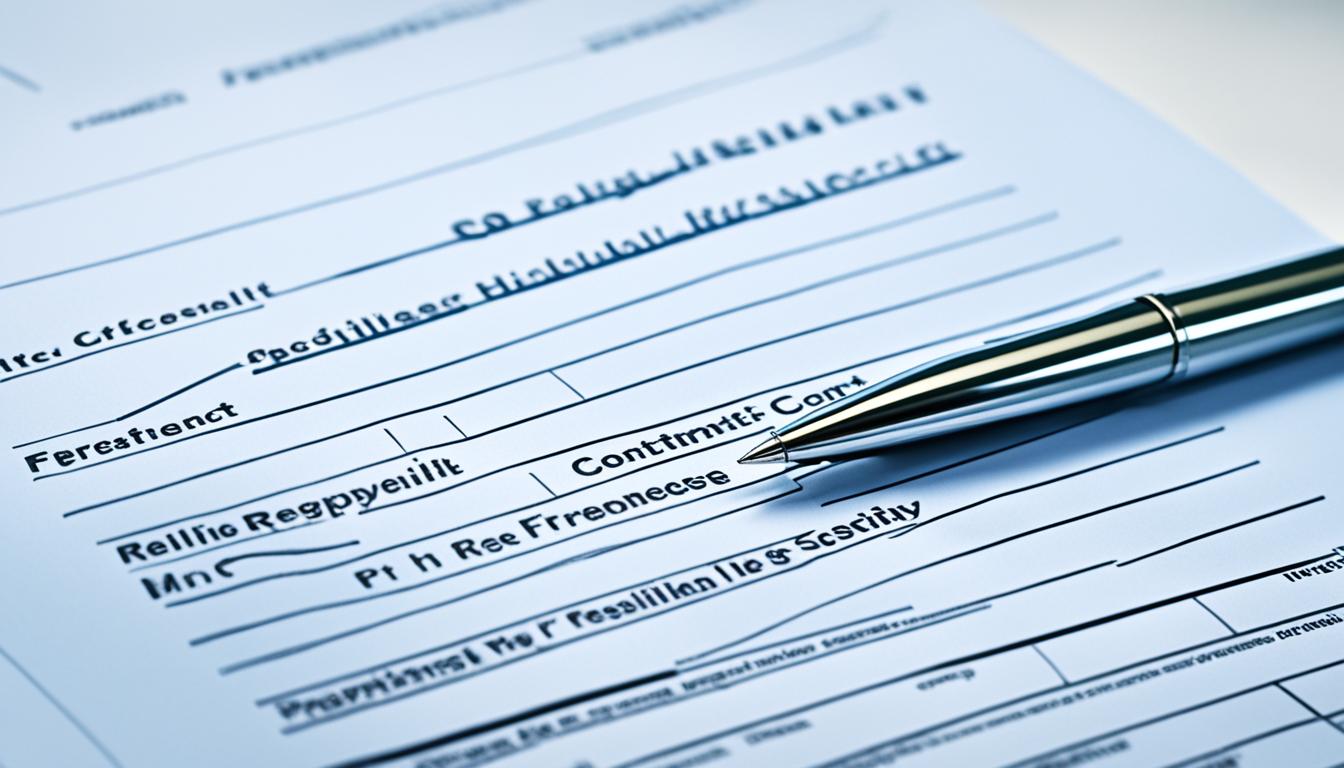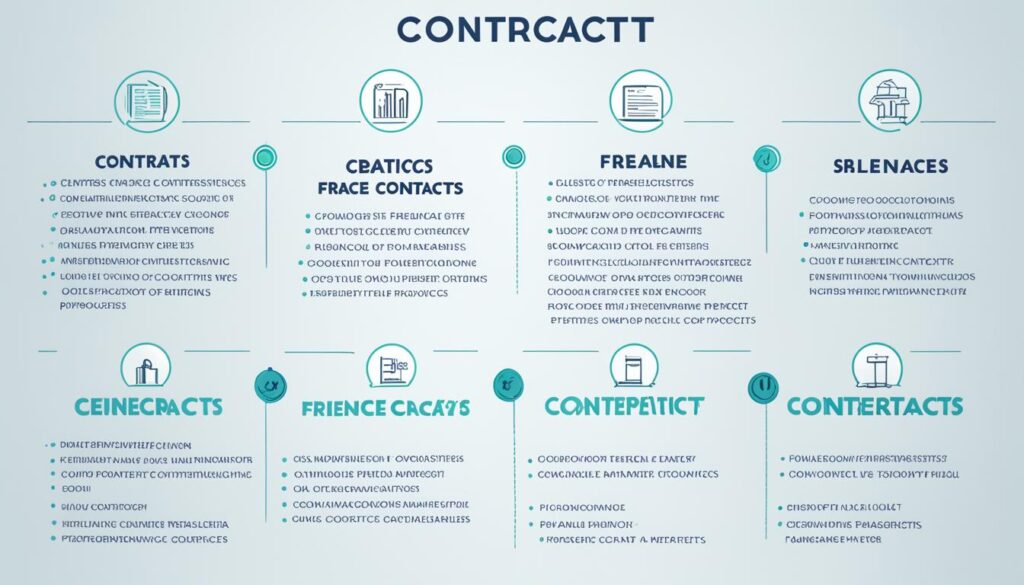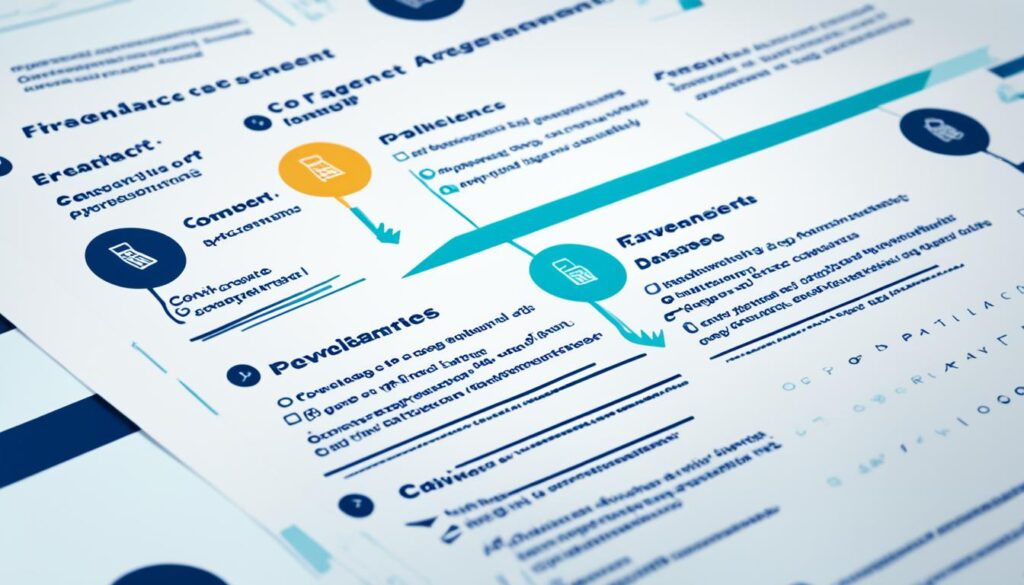Physical Address
304 North Cardinal St.
Dorchester Center, MA 02124
Physical Address
304 North Cardinal St.
Dorchester Center, MA 02124

Expertly navigate freelance contracts and agreements with insights on essential clauses, payment terms, intellectual property rights, and negotiation strategies.
Do you know that about 67.9 million people in the United States work as freelancers? They make up 42% of the workforce. Contracts are crucial in freelancing. They help freelancers and clients work well together. This guide will explain why contracts matter, what to include, and how to negotiate them. We’ll also look at the legal side, discussing things like intellectual property rights and confidentiality.
Freelance contracts are key in professional engagements. They lay out the project’s scope, deadlines, and how much and when the freelancer will be paid. This agreement acts as a guide for the whole project, making sure everyone understands their part. It also helps set clear expectations, protects legally, and ensures the job’s pay and scope, preventing confusion.
These contracts set clear expectations by detailing what each party will do and when. This makes sure everyone knows what’s needed, which lowers the chance of things going off track.
Having a written contract helps settle arguments legally. Studies show freelancers with contracts are halved in facing payment issues, compared to those without.
Defining payment terms clearly in the contract helps avoid money problems. About 60% less late payments happen in agreements with well-defined payment rules.
A detailed project description in the contract helps keep the work focused. When the job’s details are clear, almost three-quarters of freelancers say it helps prevent work from ballooning beyond what was agreed.
A good freelance contract should cover important points. These include what the project is about, how and when you get paid, who owns the project once it’s done, and how to handle issues or ending the contract. Addressing these topics helps everyone involved know what to expect.
This part explains what the freelancer will do. It lists the tasks, what will be delivered, due dates, and what the client hopes to get out of it. Clearly outlining these details makes sure both the freelancer and client are on the same page.
This section talks about money. It says how much the freelancer will be paid, when and how they will get the money, and any extra costs. Making these terms clear helps avoid confusion for both sides.
Who owns the work being done is covered here. It also says if the client can use the work in certain ways. This part prevents arguments over the use of the work later on.
This covers keeping things secret. It stops either side from sharing private information without permission. These terms show that the work and information are safe, which builds trust.
If the project needs to stop early, this section explains how. It might include how much notice is needed and if any fees apply. Clear rules for ending the contract help both the freelancer and client understand their rights in such cases.
If there’s a big problem, this part talks about how to fix it. It might involve talking, getting a third person to help, or using an agreed-upon way to settle the issue. A clear plan to handle conflicts keeps the working atmosphere positive.
Using these key elements in a contract helps everyone know what they’re in for. It guides how the work will go, how to deal with money and problems, and how the work belongs to once it’s finished. A well-written contract is good for both the freelancer and the client.

Creating your first freelance contract might feel big, but it’s not so hard if you take it step by step. Here’s how you can make a solid freelance contract:
Gather all the project details, such as the scope of work, deadline, the cost, and what the client needs. You can use a contract template or make your own. Make sure it includes all the key points.
Make the contract fit your project by adding or changing parts. This ensures it’s really clear and meets your unique job needs. Next, carefully check the whole document for mistakes or things that aren’t clear.
If you’re worried or confused, talking to a freelance contracts lawyer can help. It’s always good to get legal advice if you’re not sure about something. Finally, once everyone is happy, make it official by signing the contract.
Following these steps helps you create a strong, tailor-made freelance work agreement. It protects you, clarifies your job, and leads to a good partnership with your client. A carefully made freelance contract is key for dealing with intellectual property rights and getting paid on time.
When making a freelance contract, knowing common errors is crucial. This knowledge keeps your work relationships strong. Here are some mistakes to watch out for:
Avoid using unclear wording in your contract. Make all terms and conditions crystal clear. This prevents any confusion later on.
It’s vital to clearly state the payment terms. Define the project fee, how and when you’ll get paid, and what happens if payments are late. This clarity helps avoid conflicts over money.
Know the freelance contract laws in your area. Ignoring these legal matters could make your contract invalid. Be sure you’re on top of any rules that apply to your work.
Define the scope of work and its limits precisely. This clarity helps prevent clients from asking for more work without paying extra. Set clear boundaries from the start.
Freelance contracts vary depending on the project. The two main types are project-based and retainer contracts.
Project-based contracts are for one-off projects. They include details like what’s expected, when it’s due, and how much you’ll get paid. After finishing the work, the contract ends.
Retainer contracts are long-term deals. They set a fixed monthly payment for a set amount of work or availability. These provide more steady work for freelancers.

| Project-Based Contracts | Retainer Contracts |
|---|---|
| Used for one-time, specific projects | Ongoing agreements with fixed monthly payments |
| Outline deliverables, timeline, and payment terms | Provide a predetermined amount of work or availability |
| Contract ends upon project completion | Offer more stability and reliable income stream |
Being a freelancer means protecting your work and yourself through a formal freelance contract. This contract lays out what each side expects. It builds trust and a clear work relationship with your clients. It’s all about being clear, following the rules, and staying professional wherever you are.
A freelance contract makes sure both you and your client know what’s what. It talks about what needs doing, when it needs doing, how you’ll be paid, and other important stuff. With a clear freelance work agreement, everyone knows their part. This stops confusion and makes sure the job goes well.
Knowing how to deal with freelance contract negotiation is key for freelancers. It can change how much you earn and the working rules. It’s smart to get what intellectual property rights and confidentiality agreements you need. This way, you keep your work safe and get along with your clients.
When working out a deal, think through it every step. A good client works with you to make a fair deal. They care about the contract and treat you right. Knowing about freelance contracts and talking over the details helps. It also means thinking about what it means to be your own boss. This way, freelancers can look after themselves, make good ties with clients, and do well in the long run.
Learning how to negotiate a freelance contract is crucial for success. It can greatly affect how much money you make and your work environment. Here are some tips to help you through contract discussions:
Start by looking into what others in your field make. Figure out what you want to earn. Then, get ready to talk about fair pay and working conditions.
Know what the person hiring you cares about. Try to make your points in a way that matches their goals. This will make it easier to find solutions that work for both of you.
Show the client why you’re valuable. Explain how your skills can help their business grow. Make sure they understand the benefits they’ll get from your work.
Keep an open mind when the client gives feedback. Working together and being flexible can help you both reach a deal you’re happy with.
After you’ve talked through everything, make sure it’s all in the contract. This helps everyone see clearly what’s expected. It also avoids future misunderstandings.
A well-structured freelance contract should cover key elements. It should start with the contact info of freelancer and client.
This includes full names, addresses, emails, and phones for both parties.
It outlines what the freelancer will do. This part talks about the project details, goals, and what is expected at the end.
The contract also sets up when things will be done. It marks clear dates for each task or goal.
This part explains how the freelancer will be paid. It includes the rate, when payments happen, and any extra costs.
It lays out who owns the work and its rights. It also says what the work can’t be used for.
Both sides agree to keep private info secret. They promise not to share it with others.
This explains when and how the contract can end early. It also talks about any warning before ending and any money owed.
This part has how disagreements will be solved. It might include talking it out or using an arbitrator. It also talks about where any legal issues will be handled.
It makes sure both parties know the laws that the contract follows.
Finally, the freelancer and client sign. This shows they both agree to everything in the contract.

Independent contractors often work with just one client for a longer time. Even then, they keep their freedom more than regular employees. It’s key to decide if a contractor is truly independent or should be seen as an employee. If companies control the how and when of your work, you might be considered an employee. But if you control these things, you’re usually seen as a contractor.
IRS has a rule that says contractors handle both how they work and their pay. This means companies can’t make them sign agreements that stop them from working elsewhere. This is crucial for freelancers like writers and designers. They need their freedom and choices.
The use of contractors and freelancers is growing in the U.S. In 2018, about 20% of U.S. jobs were these kinds. By September 2020, it went up to 36%. Upwork says by 2027, there could be 86.5 million of these workers. They like the freedom and cost savings they bring.
Businesses enjoy the flexibility that contractors provide. They can hire more or less as needed and get special skills. But, companies must be careful not to call someone a contractor when they should be an employee. This mistake can lead to fines and legal troubles, warns NOLO. To deal with this, TechTarget advises having clear rules and staying in touch with your workers.
There are tools available to help with managing contractors, like those offered by PayInOne. Websites like Upwork and Freelancer.com also provide support. With the right knowledge and tools, independent workers can make the most of their situations. They can avoid problems and make sure they are treated and paid fairly.

When starting work with a new client, it’s wise to be careful and thorough. A smart client will work with you to make sure the contract is fair. They will focus on key aspects like payment terms and who owns the work (intellectual property rights).
They will also consider how to end the work if needed (termination clause). Plus, they’d plan on how to solve any issues that might come up (dispute resolution). Understanding these parts helps freelancers protect themselves and build trust with clients.
It’s important to also navigate through the negotiation process wisely. This lets freelancers show their value and learn what the client really wants. Knowing about project-based and retainer contracts helps freelancers pick what’s best for them.
Thinking about the freelancer status and ending the contract well can lead to long-term success. A good wrap-up builds trust and might bring more work later. Communicating openly and negotiating well are key for a successful end. This protects the freelancer and makes their client ties stronger.